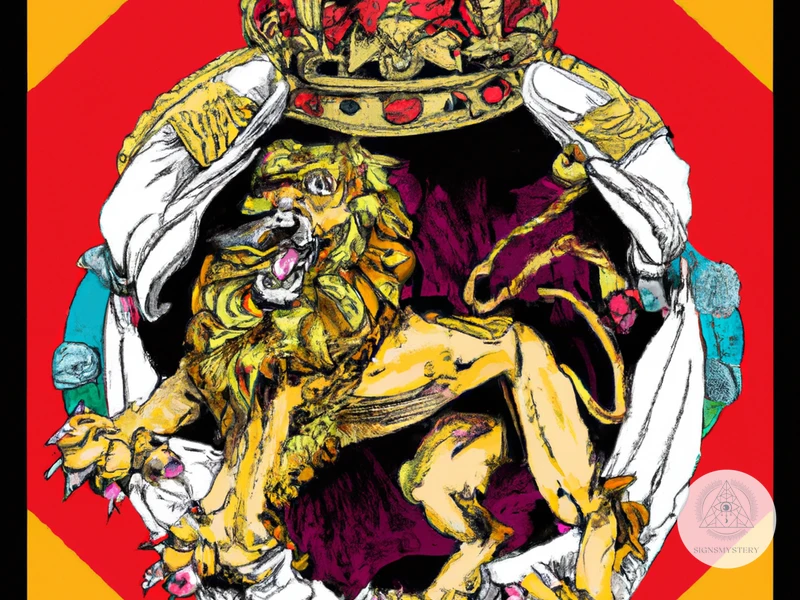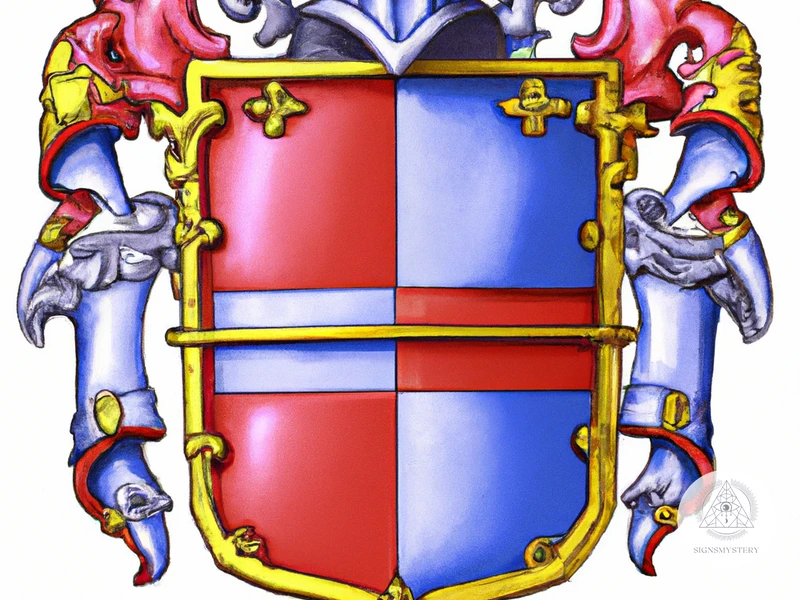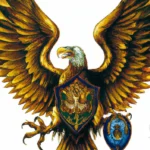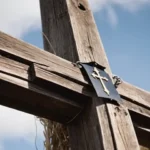Have you ever noticed the intricate, ornamental drapery that surrounds a Coat of Arms? This is known as Mantling, and it was originally used for practical reasons in medieval times. However, over the years, it has evolved into an important aspect of heraldry, symbolizing a variety of meanings and bringing life and color to a coat of arms. In this article, we will delve into the history and symbolism of mantling, explore its various designs and styles, and compare it to the often-confused heraldic crest. So, grab your shield and let’s discover the fascinating significance of Mantling in Heraldry.
What is Mantling?

Mantling is an essential element of heraldry that has been around for centuries. It is a piece of cloth that frames the shield, serving both a decorative and protective function. The mantling, while not a part of the coat of arms, can provide insight into family history, as colors and materials used were often significant and meaningful for the family. The mantling also adds beauty and artistry to the coat of arms, with various styles and types of mantling available. Some of these styles can be seen in famous coats of arms, such as the British Royal coat of arms. To fully comprehend the importance of mantling, it is essential to understand its definition, origin and evolution, as well as the symbolism behind it. For a beginner’s guide to other heraldic elements, check out resources like “The Meaning behind Coat of Arms Divisions” or “The Significance of Tinctures in Heraldry”.
Definition
Definition: Mantling is a decorative element in heraldry that is depicted in a stylized cloth draped over the helmet of a coat of arms. It is also known as a mantle, lambrequin, or the mantling of an achievement.
Mantling is typically positioned behind the shield and crest of a coat of arms, and it flows down in a symmetrical pattern. While its original function was to provide protection from the sun, wind, and rain, it later became a status symbol and an important component in the design of a coat of arms.
In terms of its appearance, mantling can be made out of various materials such as silk, velvet, or fur. It is often depicted in two different colors, with the outer color being the dominant shade and the inner color providing a contrast.
The use of mantling is an essential aspect of traditional heraldry, and it plays an important role in creating an elaborate and visually appealing coat of arms.
Origin and Evolution
The origin of mantling is not entirely clear, but it is believed to have developed in the Middle Ages as a practical element of heraldry. Its purpose was to protect the wearer from the harsh rays of the sun during tournaments and battles. Initially, feathers, leaves, or fabric were used for this purpose, but as heraldry became more refined, the mantling evolved into a more ornamental element of heraldry.
Over time, the shape and design of the mantling also evolved. Initially, it was depicted as a simple piece of cloth draped over the helmet, but in the 14th century, it began to take on a more elaborate shape, resembling folds of fabric or drapery. By the 16th century, the mantling had become a stylized representation of fabric, with elaborate tassels and fringes.
The evolution of mantling is closely tied to the evolution of heraldry itself. As coats of arms became more complex, so did the mantling that surrounded them. Mantling was often designed to complement the colors and symbols of the coat of arms, and it was expected to be unique to the individual or family that it represented.
As heraldry declined in popularity in the 19th and 20th centuries, the use of mantling also declined. Today, it is primarily used in official coats of arms, such as those of countries, cities, and universities. However, it can still be seen in the coats of arms of many families and individuals who continue to value this ancient tradition.
The origin and evolution of mantling demonstrates the enduring significance of heraldic traditions in contemporary society. Understanding the history and symbolism of this ancient element of heraldry can help us appreciate the beauty and complexity of heraldic achievements and their significance in history and modern culture.
The Symbolism behind Mantling
Mantling in heraldry has deep symbolic meaning attached to it. Colors and materials used in the creation of mantling hold significant importance. For instance, ermine fur was once reserved for royalty and represented purity, while azure blue represented loyalty. Mantling also serves to connect the coat of arms with the individual bearer, as it drapes over the helmet. The intricate designs and variations of mantling can be seen in famous coats of arms, showcasing the creativity and craftsmanship that was once essential to heraldic achievement. Understanding the symbolism behind mantling is just one aspect of comprehending the complex language of heraldry. To delve deeper, one can explore the meanings behind crests, animal symbolism, and the different types of heraldic shields, among other heraldic terms and meanings.
Significance of Colors and Materials
In heraldry, every color and material used in the creation of armorial bearings has a symbolic purpose, and mantling is no exception. The colors and materials used in a mantle can give insight into the personality, values, achievements, or region of the person or institution represented. Here are some of the most common materials and colors used in mantling and their significance:
| Material | Color | Significance |
|---|---|---|
| Ermine | White with black spots | Represents purity, innocence, and dignity |
| Vair | Blue and white | Symbolizes a connection to a specific region or region-specific achievements |
| Gules | Red | Represents military or warrior strength, magnanimity, and bravery |
| Purpure | Purple | Indicates sovereignty, majesty, and regal power |
| Or | Gold | Indicates generosity, elevation of the mind, and nobility |
| Argent | Silver or white | Indicates peace and sincerity, or is used as a metal substitute for other colors when needed |
It’s worth noting that these colors can be arranged in any number of ways and combined with other colors, depending on the person or institution being represented, their geographic location, and their achievements. This makes the interpretations of coats of arms and their mantling complex and fascinating.
The materials used in mantling can also carry symbolic meaning. For example, more luxurious materials like silk, velvet, or fur were traditionally used to indicate wealth, status, or proximity to royalty. Conversely, less luxurious materials like linen or wool were used to indicate a more humble origin or a connection to a particular trade or occupation.
The colors and materials used in mantling play an important role in heraldry. They can offer insight into the values, achievements, or region associated with the person or institution represented. The specific configuration of these materials and colors can make each coat of arms unique and full of meaning.
How Mantling Connects with the Coat of Arms
How Mantling Connects with the Coat of Arms:
Mantling is a unique component of a Coat of Arms that serves to frame the escutcheon or shield, essentially providing a decorative covering. However, it’s not just mere decoration as it can convey important information about the person or family represented by the Coat of Arms.
Mantling is typically designed to complement the Coat of Arms, and the colors used in the mantling often reflect the tinctures used in the Coat of Arms. The style and materials used in the mantling may also reflect the social status and symbolism of the person or family to whom the Coat of Arms belongs.
In terms of how mantling connects with the Coat of Arms, it can help to enhance the overall symbolism and meaning of the heraldic achievement. The mantling may incorporate specific charges or symbols that relate to the owner of the Coat of Arms. For example, if the Coat of Arms includes a lion charge, the mantling may have a lion’s head incorporated into the design.
The mantling can also serve to help define the shape and size of the Coat of Arms. It may be used to provide a sense of balance or proportion to the design. As such, the mantling can be viewed as an important element in creating a cohesive and visually appealing Coat of Arms.
The mantling is a decorative covering that serves to frame the escutcheon or shield of a Coat of Arms. It is an important component that helps to enhance the overall symbolism and meaning of the heraldic achievement. The use of specific colors, materials, designs, and charges in the mantling can provide important information about the person or family represented by the Coat of Arms.
Designs and Variations

In the world of heraldry, mantling is more than just a decorative flourish surrounding the shield. It has evolved over time and has had a range of styles and types across cultures. The most common style features a basic mantle shape with cut-outs, embroidery, and tassels. However, it can be made from various materials and colors that hold significance in heraldry. For example, ermine represents dignity and ermine tails depict high social status, while gold indicates generosity and loyalty. Designs may also vary, with some mantles possessing specific motifs like foliage, flames, or curving patterns. Famous examples of mantling can be found in the Coats of Arms of the United Kingdom and the United States. Understanding the nuances of mantling aesthetics and symbols is an essential factor in comprehending the entirety of heraldic achievements.
Style and Types of Mantling
Mantling comes in different styles and types that add character and personality to a coat of arms. One of the most common and widely used styles of mantling is the draped or swagged style. In this style, the mantling is draped over a helmet or a crest from one side to the other in a flowing and natural manner.
Another popular and interesting style is called the mantling with tails, where a few “tails” of fabric extend from the mantling and flow downward. The tails can be either twisted or tied in knots for added ornamentation.
Additionally, some coats of arms feature mantling with a scalloped edge, which gives them a more intricate and ornate appearance. The scallops are usually designed to symbolize waves or feathers, depending on the intended symbolism of the coat of arms.
In terms of types, mantling is broadly categorized into two types – closed and open mantling. Closed mantling wraps around the shield, while open mantling hangs freely without draping around or covering the shield. Closed mantling is considered more traditional, while open mantling is a modern touch to heraldry.
The type and style of mantling chosen for a coat of arms often depends on its intended symbolism and the coat of arms’ heraldry animal symbolism. The color and material of the mantling are also chosen keeping in view the intended message conveyed by the coat of arms.
The types and styles of mantling enable designers to create unique and distinctive coats of arms that match their intended purpose and symbolism. Mantling is an integral part of the heraldic achievements, and its importance cannot be overlooked in the design of a coat of arms.
Examples of Mantling in Famous Coats of Arms
Mantling has been a common feature in coats of arms for centuries, and there are plenty of famous examples of its use. The coat of arms of the United Kingdom, for example, features a mantling of ermine and gold, which represents the sovereignty and authority of the monarch.
Another famous coat of arms that features mantling is that of the city of London. Its mantling is comprised of alternating red and white silk, which represents the city’s status as a center of trade and commerce.
The coat of arms of the state of California also features mantling in the form of a green and gold wreath of oak and laurel leaves. This design represents the state’s natural beauty and its history as a stronghold of the entertainment industry.
Other famous examples of mantling can be found in the coats of arms of various royal families, such as the House of Windsor, the House of Habsburg, and the House of Bourbon.
In each case, the use of mantling serves to reinforce the symbolic significance of the coat of arms, highlighting the qualities and achievements of the individual or organization being represented.
If you want to learn more about other elements that can be found in coats of arms, you can check our article on heraldic charges, which are symbols that can be added to the shield. You can also find useful information on heraldic shields, which can be used to display coats of arms, or on the symbolism of colors in heraldry. And to discover the meaning of other heraldic terms, you can visit our glossary of heraldic terms.
Mantling versus the Crest
One common confusion in heraldry is the difference between mantling and the crest. Mantling is the decorative drapery-like material that frames the coat of arms, while the crest is the image that sits atop the helmet in full armorial achievements. While both elements are integral to a coat of arms, they serve different purposes and have distinct features. Mantling is typically made up of two tinctures, a main color and a secondary color, and is designed to add an aesthetically pleasing decorative element to the overall design. On the other hand, the crest is a three-dimensional figurine that
Subscribe to Our Newsletter
Sign up to receive the latest news and updates.
Comparing Mantling and Crests
Comparing Mantling and Crests can be a confusing task for many enthusiasts of heraldry. While they are both significant components of a coat of arms, they have distinct features that differentiate them from each other. Here is a breakdown of the differences between Mantling and Crests:
Position
Mantling is positioned like a cloak or hood that surrounds the shield, while the crest is placed on top of the helmet that covers the shield.
Design
Mantling is made up of decorative designs that cover the entire shield, while the crest is a smaller design that sits on top of a helmet.
Material
Mantling is usually made of cloth or velvet, while the crest is made of a variety of materials such as metal, feathers, and even wood.
Symbolism
Mantling has a symbolic connection to Medieval tournament gear, while the crest represents a family’s unique history, achievements, and values.
Usage
Mantling is an optional accessory to a coat of arms, while the crest is always included as a central element of a coat of arms.
To summarize, Mantling and Crests are both important components of a coat of arms, but they have distinct differences in their design, position, material, symbolism, and usage. While Mantling is optional and simply adds decorative value, the crest is a necessary element in a coat of arms as it represents the family’s identity and heritage.
The Relationship between Mantling and Crests
The relationship between mantling and crests is a crucial aspect of heraldry. While mantling is a decorative ornamentation that frames the coat of arms, the crest is a symbolic representation of the family name. However, these two elements are intricately connected, and their relationship depends largely on the symbolism behind each.
Mantling and Crests Comparison
| Mantling | Crests |
| — | — |
| Ornamentation for the helmet and the shield | Symbolic representation of the family name |
| Serves as a decorative frame for the coat of arms | Positioned on top of the helmet |
| Can be stylized in different ways to give a unique appearance to the coat of arms | Represents a family value, achievement, or occupation |
| Often made with textile materials like silk, satin, and velvet | Can be made of various materials like wood or metal |
Their Significance
Mantling and crests complement each other, and their symbolism is critical in defining the coat of arms. The crest is usually positioned on top of the helmet, and it represents a value, achievement, or occupation of the family. On the other hand, mantling serves as a decorative ornamentation that frames the coat of arms, giving it an aesthetically pleasing appearance.
Examples
Take, for instance, the coat of arms of England, which has a crest of a lion wearing a crown, positioned on top of the helmet. The mantling, in this case, is stylized in a rich blue and gold color scheme, which represents royalty and wealth.
Similarly, the coat of arms of Scotland has a crest of a lion rampant wearing a crown, positioned on top of the helmet. The mantling is stylized in a rich blue and white pattern, which is the national color of Scotland.
The Connection between Mantling and Crests
While mantling and crests have different roles in defining the coat of arms, their interconnection is essential in producing a harmonious and meaningful design. The style and color of the mantling often complement the crest, reinforcing the values and symbolisms behind the coat of arms.
The relationship between mantling and crests is vital in defining the coat of arms and reinforcing the values and symbolisms behind it. Mantling serves as a decorative ornamentation that frames the coat of arms, while crests represent the family’s values, achievements, or occupations. Together, they form a harmonious and meaningful design that reflects the family’s heritage and history.
Conclusion
In conclusion, it is clear that Mantling plays a vital role in Heraldry. It adds an extra layer of symbolism to the Coat of Arms, highlighting the values and beliefs of the family or individual it represents. The variety in materials and colors used in Mantling design allows for a personal touch in a coat of arms. Though it is often confused with the Crest, Mantling serves a distinct purpose, providing a decorative frame for the shield. Additionally, there are no strict rules on how Mantling should look, allowing for individual creativity in design. Whether through a simple ribbon style or intricate, three-dimensional draping, the possibilities are endless. Overall, Mantling serves as a bridge between the past and present, connecting family lineage and personal values in a coat of arms.
Summary of Key Points
The summary of key points is an essential section where we reiterate the main takeaways from the article. These points encompass the significance of mantling in heraldry – a tradition rooted in European aristocracy and nobility.
Mantling is a term used to describe the decorative drapery that surrounds the helmet and shield in a coat of arms. It serves as a protective feature for the wearer and adds to the overall aesthetic and symbolism of the coat of arms.
The origin and evolution of mantling can be traced back to medieval times when it was used as a practical accessory during wars and tournaments. Over time, it evolved into a more decorative element that highlighted the wearer’s social status and achievements.
The symbolism behind mantling is rooted in the choice of colors and materials used in the design. Each element has a significance that reflects the wearer’s character, lineage, and achievements. It serves as a connection between the coat of arms and the wearer’s identity.
The designs and variations of mantling showcase the diversity and creativity inherent in heraldry. Different styles and types serve as a visual representation of the wearer’s personality, interests, and values. Famous examples of mantling in coats of arms include those of the British royal family, the United States of America, and the Vatican City.
In comparing mantling and crests, we can see that while there are some similarities, they serve different purposes. Mantling is a decorative feature that enhances the coat of arms, whereas crests are a symbol of personal achievement that sits atop the helmet. However, they both serve to represent the wearer’s identity and achievements.
The importance of mantling in heraldry cannot be overstated. It serves as a visual representation of the wearer’s character, lineage, and achievements. It is a tradition that has evolved through history and continues to express creativity, diversity, and symbolism in modern-day heraldry.
Final Thoughts
Final Thoughts
Here are some final thoughts on the importance of mantling in heraldry:
1. Mantling may seem like a small, insignificant detail in heraldry, but it is actually a crucial element that adds depth and meaning to a coat of arms.
2. The symbolism behind the colors and materials used in mantling can tell a story about the history and values of the individual or family represented by the coat of arms.
3. Different styles and variations of mantling can offer insight into the artistic preferences and cultural influences of the time period in which the coat of arms was created.
4. While the crest may be the most recognizable part of a coat of arms, mantling serves a key role in connecting the crest to the rest of the design and tying everything together.
5. Understanding the importance of mantling in heraldry can help us appreciate the significance of these ancient symbols of power and identity, and inspire us to continue exploring the rich history and tradition of heraldry.
Mantling is a fascinating and complex aspect of heraldry that deserves more attention and appreciation. Whether you are a heraldry enthusiast, a history buff, or simply curious about the world around you, taking the time to learn about the importance of mantling in heraldry can deepen your understanding of this timeless art form and provide a window into the fascinating world of medieval Europe.
Frequently Asked Questions
What is the purpose of mantling in heraldry?
The purpose of mantling in heraldry is to serve as a decorative element that frames and enhances the coat of arms.
What materials were traditionally used to make mantling?
Traditional materials used to make mantling include silk, velvet, and fur.
Why are the colors used in mantling important?
The colors used in mantling are important as they can represent various meanings and symbolisms, such as loyalty, bravery, and royalty.
How does mantling differ from the supporters in heraldry?
Mantling serves as a decorative element that frames the coat of arms, while supporters are figures that typically stand beside the shield and support it.
Can a coat of arms have more than one type of mantling?
Yes, a coat of arms can have more than one type of mantling, such as a combination of wreaths and mantles.
What is the most common style of mantling?
The most common style of mantling is the draped style, which resembles a loose, flowing cloth.
What are some modern materials that can be used to create mantling?
Modern materials that can be used to create mantling include various fabrics and synthetic materials such as nylon.
How does the placement of mantling differ in different variations of heraldry?
The placement of mantling can differ depending on the variation of heraldry, such as where it is positioned in relation to the coat of arms and the type of embellishments used.
Can a family choose to change the colors or style of their mantling over time?
Yes, a family can choose to change the colors or style of their mantling over time, as long as they follow the rules and guidelines of heraldry.
What should be considered when designing a mantling for a new coat of arms?
When designing a mantling for a new coat of arms, one should consider the symbolism of the colors and materials used, as well as how it will complement and enhance the overall design of the coat of arms.










